Voynich star names: an analysis (1)
The Voynich manuscript (VM) contains dozens of pictures of stars alongside what appear to be labels and names.
In our attempt to decipher the manuscript’s content it would therefore seem an obvious strategy to look systematically at these labels for clues to help us in decipherment. We could draw on the extensive research and scholarship into the star names we use today, and the origins, transmission and transmutation of those names over centuries.
This would help in decipherment because if we could find common star names in the VM and in systems which we know from elsewhere, this could give us important clues as to the sound-sign correspondences in the VM which could help us to crack the code This is in analogy with what I have tried to do in my earlier paper with (mainly) plant names.
In this light I find it remarkable that in the 100 years or so since the VM’s rediscovery there has been almost no serious systematic study of these star names 국민 체조 다운로드. By ‘serious and systematic’ I do not include those attempts which choose possible names to support a pre-formed argument or theory (such as the approach used by Han here). I am thinking instead of more academic studies which would start with an open mind and seek to look at the evidence of the star names in the manuscript as it stands, and then compare the evidence with what we know about other star naming systems, without any grand a priori assumptions, and not seeking to support a pre-formed conclusion about the manuscript.
You can see for yourself how rare (i.e. non-existent) such studies are by means of a search through Google Scholar, as I have done here. Apart from many links which are irrelevant because they don’t consider the VM at all, such a search brings up remarkably few relevant discussions. The few which do emerge are d’Imperio’s study (1978), to be discussed below, a few papers by Brumbaugh (e.g. 1976) also to be considered below, a link to the Montemurro et al Math Thief.  paper which hardly mentions stars at all, and nothing else of substance at all. That’s surprising, isn’t it?
In this and some later blog postings I hope to make a start to remedy that deficiency. It is obviously not possible in this kind of forum to produce the full, professional analysis of VM star names which I think is both necessary and possible, but I intend at least to make a start .
One of my aims, as in this website as a whole, is to open up discussion to other people – so feel free to add your views as we go.
Before we start on the discussion itself however, let us look at those few studies which have been written, i.e.those mentioned above.
D’Imperio’s study
D’Imperio’s 1978 work, which is still required reading by anyone interested in serious study of the manuscript (and which can be found in full here) offers no real analysis of the star names other than to say:
“Attempts to cross-match the rings of text around sun and moon, or the labels of individual stars on the two folios have so far been fruitless.” (D’Imperio p17)
However,  she clearly feels it is worth studying, since she says of the pages with star and other cosmological information:
“[s]urely a careful and determined analysis of this wealth of structured content in conjunction with a study of medieval doctrines should turn up something of use to us in interpreting the meaning of the diagrams.” (p17)
I agree with her completely on that. She feels that such a study had not been done up to 1978; also interesting is her view that such a study should be linked with what we already know about mediaeval ‘doctrines’ want you to go download. What is surprising to me is that no-one since 1978 has tried to do it either, at least in terms of the star names.
Brumbaugh
In the 1970’s (in fact before D’Imperio’s monograph) Brumbaugh produced a series of claims that he had ‘cracked the code’, among them an article on the VM star names  which he claimed he had deciphered (see the article here). In that article he boldly states: “In 1972 I finally solved the Voynich cipher” (Brumbaugh 1976:140).
Before addressing his decipherments themselves, it is interesting to reproduce a few of Brumbaugh’s observations concerning what he terms the ‘star names’, to give a flavour of his work:
“The star-map section raises problems. The star maps are a set of twelve, representing ten signs of the zodiac; originally there must have been at least one for each sign of the zodiac, but if so, two have been lost. Each ‘map’ has a central medallion with a picture of the zodiacal constellation, with the month name written beneath in plain text. Around this, in an inner circle, the maps have a ring of female figures, each attached by a line to a star. An outer circle has more such figures ie8 한글판 다운로드. A group of numerals is written next to each star.” (Brumbaugh 1976:141)
On the next page he continues as follows:
“A group of cipher numerals is written next to each star. A first try at decipherment gave the name of Alfred for the star in the Pisces medallion, with Urifydes just above and Alfansus Purus on to the right. The names are therefore those of the great men whose souls are attached to stars, rather than anything else they might be—Arabic star names, or a numerical Messier listing, for example.” (Brumbaugh 1976:142)
Brumbaugh does not give details about his decipherment, and it is even not clear from this which precise words he was deciphering (e.g. in the Pisces ‘medallion’). Unfortunately, partly because of this sort of vagueness, his resulting decipherment did not find favour with other scholars. D’Imperio was carefully polite about it, but concluded that:
“There is just enough plausibility in the process to lead one on 쇼미더머니777 4화 다운로드. but not enough to leave one satisfied.” (D’Imperio 1978 p38)
and his scheme of decipherment is now largely forgotten.
In terms of his analysis of the star names, I would further argue that he made a number of fundamental assumptions which are questionable, even untenable. In the quotations  above, for example, he assumes that what we now call the Zodiac pages are in fact ‘star maps’. This involves the assumption that the drawings of star-shaped objects attached to lines or strings are necessarily meant to represent stars, as he says on pages 140 and 141, although by page 142 he has revised this to suggest they represent not stars themselves but ‘great men whose souls are attached to stars‘.
This raises a crucial question which to my mind (and again to my surprise) has not been carefully addressed in Voynich scholarship so far, neither by D’Imperio, nor by Brumbaugh, nor apparently by anyone else, namely which star-like drawings with labels in the manuscript should we take with confidence to represent stars, and which should we exclude from our analysis because they might not represent stars? According to page 18 of Tiltmans’ 1968 article, there are about 550 “star shapes” in the Voynich manuscript, but these cannot all represent actual stars. We need a principled discussion to determine which to include in our analysis and which to exclude.
To put this another way, if we are to study the star names, we need to establish from the outset a principled ‘corpus’ of items of those within the manuscript which can then form a solid basis for our subsequent analysis 지식e 다운로드. This corpus must exclude items which might not be star names at all, or which are in any way doubtful. Without that clear and confident corpus, selected, argued and justified, we cannot be sure we are talking about star names at all.
So this first post will try to bring some clarity and rigour to this important question. My aim will be to determine a clear and defensible list of those ‘labels’ or ‘names’ in the Voynich manuscript which are most likely to represent actual names of stars, so than we then have a solid ‘corpus’ on which to work in future.
Star-shapes with lines or strings
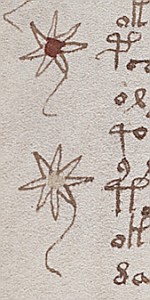 Let us start by considering star-shapes with strings, such as these (illustrated) from the bottom of f104r, and also those in the ‘Zodiac pages’ such as these ones . Some writers are rightly cautious about these, calling them “flower-like star shapes” (Montemurro et al.). Others are less cautious; René Zandbergen on his pages speaks of  some of them as “the drawing of a star in the margin” and also “30 nymphs holding stars” Vector.
Let us start by considering star-shapes with strings, such as these (illustrated) from the bottom of f104r, and also those in the ‘Zodiac pages’ such as these ones . Some writers are rightly cautious about these, calling them “flower-like star shapes” (Montemurro et al.). Others are less cautious; René Zandbergen on his pages speaks of  some of them as “the drawing of a star in the margin” and also “30 nymphs holding stars” Vector.
In my view we need to very cautious about these, since it is by no means certain that in fact they represent stars at all. They could be meant to be flowers, or suns, or something else. In their context on the Zodiac pages they could well represent ‘days’, since there is one for each of the (approximately) 28 figures in most of the months. In the last pages of the manuscript, although some of them do not have strings, such as those on page f103r here, they again seem to number around 360 or so, which again suggests that they might be intended to indicate days. In short, whatever they do represent, it is by no means certain that they are intended to represent stars, so we should exclude them.
This means that it seems more rigorous, and safest, to exclude all of these star-shapes on those pages, with or without strings, from consideration as we attempt to set up a list of star names in the Voynich manuscript, so I will not include them here.
Star-shapes in the ‘Cosmology pages’
In the co-called ‘Cosmology pages’ there are also many star-shapes, some with interesting labels beside or near them, for example on folio 67r1 here  or 68v3 here 플레이스테이션 넷플릭스 다운로드. However, in these cases it is again doubtful whether the labels are definitely meant to represent the names of the stars. Owing to the uncertainty over the meaning of the diagrams as a whole, and the positioning of the labels, they could well be intended for something else, so again it is wise to exclude these from consideration as we try to build a corpus of potential star names in the VM.
Folios 68r 1-3
However, on three of the folios of the manuscript we do seem to have a set of star shapes with associated labels which seem most probably to represent the names of the stars they are associated with. The reasons are as follows:
- on these pages the stars are clearly separate from each other, with only one label per star
- since they have a moon and a sun on two of the pages, and a moon on the third, they must be stars and not (say) flowers or days
- in the first two folios (f681-2) the star illustrations seem clearly to be positioned in the sky (between the moon and sun), and in the third they surround the moon, so again they must be meant for stars
- the labels beside each star are all different from each other, again making it likely that they are names
These elements of the context make it highly likely that the labels besides the stars in these folios are intended as names for the stars themselves. Indeed there does not seem to be any other plausible explanation of these labels in these positions.
Even so, we still need to be cautious; in at least one case, namely the set of seven stars on 68r3 (illustrated), it has already been argued (e.g. in my Feb 2014 paper here) that this label probably represents not the name of a star or stars, but the constellation Taurus 시냅스 다운로드. We also know that many star lists in mediaeval times included the planets alongside stars (see discussion here) , so among star names in the Voynich we might well expect to find names for Mercury, Venus, Mars, Jupiter and Saturn. So when we say ‘star names’ in this discussion we need to remember than we might in fact also be dealing with constellation names and planet names too.
Notwithstanding, it seems incontrovertible that the labels on these three folios must be intended as names for the objects they stand beside, be they stars, asterisms or planets. We will therefore use the labels on these three folios pages as the basis of the corpus or list of Voynich names which we can then use to compare with other star name lists in other cultures.
Numbering the starsÂ
In order to discuss and attempt to analyse the stars and their possible names, it seems important to number them so that we can discuss them more easily and specifically oracle 10g linux 다운로드. To this end I propose to use the following three illustrations of Folios 681-3, with a number beside each named star. These numbers will then allow us to list and analyse the star names more systematically – there are 64 in total.
Here I offer a download link so you can get a Word file with a list of these numbers and names.
[gview file=”https://stephenbax.net/wp-content/uploads/2014/10/Possible-star-names-in-the-Voynich-Manuscript-Folios-68r1-3.docx”]
I will also put up lists of the star names on separate pages for each folio:
Folio 68r3 Pleiades page, star names
The other two pages will follow soon.
In the next posting I will offer discussion and statistical analysis of the 64 star names identified here.
- Posted in: Voynich ♦ Voynich stars
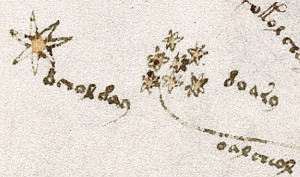
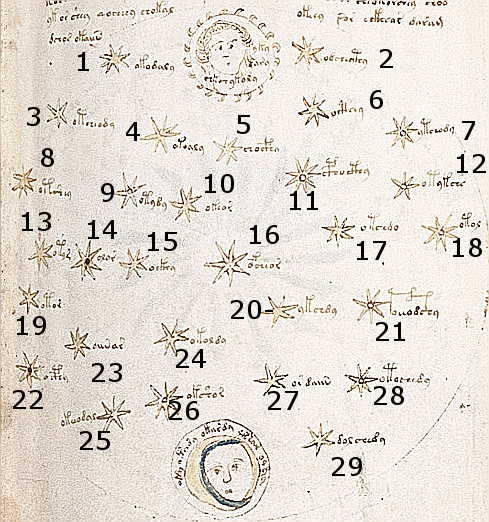
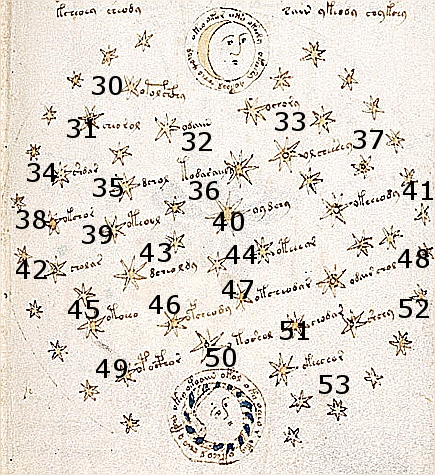
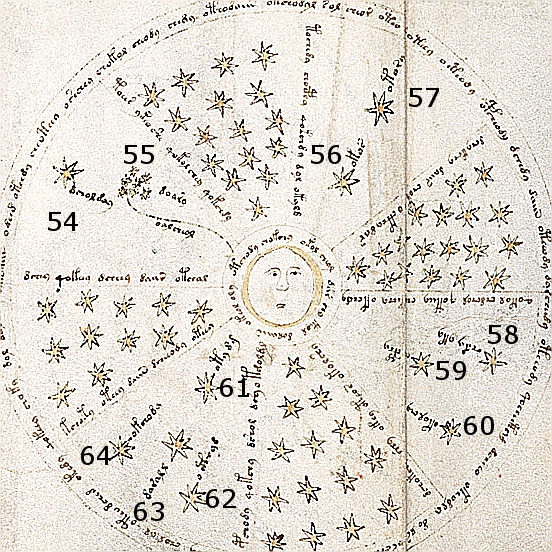
92 Comments
Trackbacks